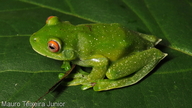|
Aplastodiscus cavicola (Cruz & Peixoto, 1985)
| family: Hylidae subfamily: Hylinae genus: Aplastodiscus |
 © 2018 Mauro Teixeira Jr (1 of 4) |
|
|
Country distribution from AmphibiaWeb's database: Brazil
|
|
|
AMPHIBIAWEB
|
|||||||||||||||||||||||||
|
(Translations may not be accurate.) |
Country distribution from AmphibiaWeb's database: Brazil
|
||||||||||||||||||||||||